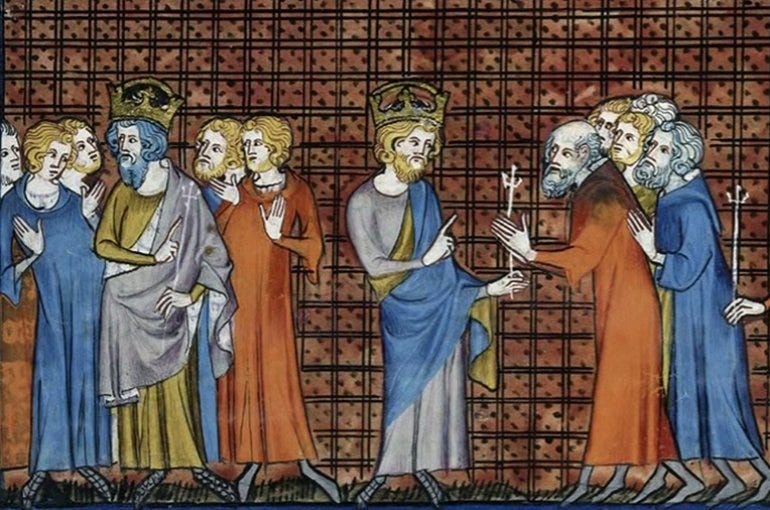Revisionist view of the Dark Ages
Review of Barbarians to Angels: The Dark Ages Reconsidered by Peter S. Wells
This is a revisionist exercise that attempts to de-bunk the visions of post-Roman collapse and chaos that were disseminated by distant contemporary Christian authors. What the author adds that is new, at least to me, is to marshal archaeological evidence to prove that the dark ages do not represent a radical discontinuity, but rather evolved naturally on a far more positive course that we typically assume. So far as it goes, Wells does get the reader to re-think things, but in the end there is not enough evidence to support his claims.
Wells attacks the question from a number of angles. First, he examines the leaders that stepped into the vacuum left by the withdrawal of Roman protection from its former territories in the wake of the empire's implosion. It was here, in the fourth chapter, that I became uneasy and confused about the direction the author wanted to take. A large part of the chapter is an imagined reconstruction of Childeric's burial, the moment of transfer of power at to his son, Clovis, who eventually converted to Christianity and supposedly established the first kingdom of France (in spite of being a German Frank). The problem for me was that I could not see where Wells was going with this long passage, however much it was based on a scrupulous interpretation of the archaeological evidence. So far as I can tell, he wanted to establish that 1) authority continued to exist in many locations where similar burials were done and 2) reference to Roman power, often in a form resembling clientage, remained strong. This is fine, but I continue to wonder how significant this finding is and what it proves.
Second, Wells embarks on a discussion of what happened to Roman cities, from a few examples, esp. Londinium (i.e. London). Once again, I can accept that the new powers took over some Roman traditions of architecture and urban organization, adapting them to their own needs (e.g. demolishing certain stone structures for building materials, ending monumental undertakings for a time, etc.). However, it is unclear that this took place in more than a handful of locales, when compared to the gigantic expanse that enjoyed relative peace and easy commerce with the protection of laws for hundreds of years. It is a question of both scale and quality, which cannot be definitely addressed with the available evidence. He also argues that new cities opened up in the North, all of which were on a more impressive scale than assumed, but again, this fails to convince.
Third, and most interesting to me, he looks at evidence for what occurred in the countryside, in specific agricultural technologies and practices. In particular, this period benefitted from the development of the horse collar, which enabled farmers to plow with greater power than oxen or avoid choking horses with the earlier harnesses designed for oxen. In addition, they began to use a metal plow that turned the soil over rather than merely cut furrows, which along with crop rotation replenished chemical nutrients and greatly enhanced productivity. As proof that people were eating very well, he cites height statistics. This was the most convincing argument for me by far that the vitality of the dark ages is under-valued.
Fourth, Wells looks at trade patterns. The most he can say here, in my view, is that it continued, only with distinct craft traditions. This is fine, but it is not the same as proving that trade equaled or surpassed that of the Roman period. There just isn't enough evidence to prove that, in spite of a Buddha statue that was found in the Sweden of 6th century. Related to this is a rather tedious description of the crafts that were under development; this can be interesting, particularly as I had just visited one site he describes, Sutton Hill, and Wells added context to what we saw, but not at the level of detail he goes into. There were common design patterns that were incorporated into artifacts. But again, I do not see that trade networks and new crafts prove that overall the dark ages overall were a time of flourishing. Also, examples of local coinage did not convince me that most areas had in fact not degenerated into barter economies.
Finally, Wells discusses the spread of Christianity alongside innumerable survivals of pagan practices. Again, this is fun and interesting, but it did not prove anything much that would advance his thesis. Irish monks did preserve literacy and stimulated many new avenues of intellectual activity, but this is already well known.
My biggest problem with the book's style is that Wells goes into many catalogue-like descriptions of artifacts and other details, but does not provide clear enough direction for what it means. I got to the end of many chapters and felt, "so what" or asked "what is he getting at?" The book lacked the density I needed to accept his arguments. I did learn a bit about dark age archaeology and the section on agriculture was very interesting, but overall I felt unsatisfied.
A related review:
Excellent survey history of the dark ages: academic, accessible, dense
While comprehensive, this survey history neither gets bogged down in obscure scholarly debates nor over-simplifies controversies on sources or interpretation for lay readers. Every page made me want to learn more in specialized sources. A demanding read, its level is advanced undergraduate or early graduate school.




